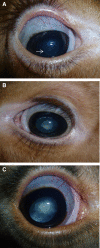Congenital cataracts in an Ayrshire herd: a herd case report
- PMID: 24460638
- PMCID: PMC3905159
- DOI: 10.1186/2046-0481-67-2
Congenital cataracts in an Ayrshire herd: a herd case report
Abstract
An Ayrshire dairy herd was investigated for occurrence of ocular abnormalities in new-born calves. Ophthalmic examinations were performed on all the animals in the herd and 26% of them were diagnosed with bilateral cataracts. Cataracts varied in extent and severity but the majority were restricted to the lens nucleus. Epidemiological analysis showed the prevalence was higher in male animals and lower in animals born to heifers. A family tree was designed but no genetic impact of dam lines was evident. Sire data was incomplete and could therefore not be included. Based on the information provided by the farmer there was no obvious environmental or nutritional cause of these cataracts. However, data records were incomplete and further investigation/monitoring of the herd would be needed to establish a cause and enable a better insight into the aetiology of this disease in cattle.
Figures



References
-
- Ellis K, Billson FM. An investigation into a herd outbreak of congenital cataracts. Cattle Pract. 2001;9:29–32.
-
- Bistner SI, Rubin L, Aguirre G. Development of the bovine eye. Am J Vet Res. 1973;34:7–12. - PubMed
LinkOut - more resources
Full Text Sources
Other Literature Sources

